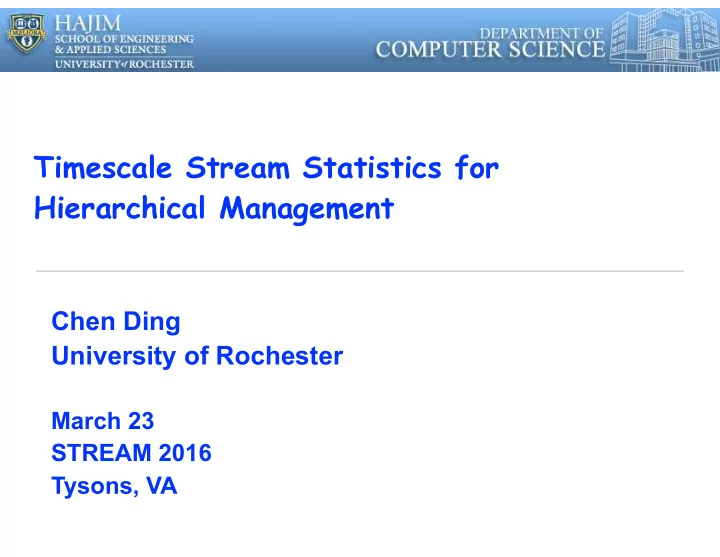

Timescale Stream Statistics for Hierarchical Management Chen Ding University of Rochester March 23 STREAM 2016 Tysons, VA
Implications of the datacenter’s shifting center. BY MIHIR NANAVATI, MALTE SCHWARZKOPF, JAKE WIRES, AND ANDREW WARFIELD Non- Volatile Storage “The arrival of high-speed, non-volatile storage … is likely the most significant architectural change that datacenter and software designers will face in the foreseeable future. ” 2 Chen Ding, University of Rochester
Hierarchical Cache Memory • Science • nothing travels faster than light • the faster the access, the smaller the data capacity • Engineering • speed, size and cost • no single technology can satisfy all demands • e.g. SCM mentioned in the CACM article • Programmability • automatic, transparent, modular, efficient, portable • efficient sharing of fast/local memory • Uses • CPU/GPU caches, virtual memory • software cache, e.g. Memcached, Redis 3
GPU G80 GT200 Fermi Transistors 681 million 1.4 billion 3.0 billion CUDA Cores 128 240 512 None 30 FMA ops / clock 256 FMA ops /clock Double Precision Floating Point Capability 128 MAD 240 MAD ops / 512 FMA ops /clock Single Precision Floating ops/clock clock Point Capability Special Function Units 2 2 4 (SFUs) / SM 1 1 2 Warp schedulers (per SM) 16 KB 16 KB Configurable 48 KB or Shared Memory (per SM) 16 KB None None Configurable 16 KB or L1 Cache (per SM) 48 KB L2 Cache None None 768 KB ECC Memory Support No No Yes Concurrent Kernels No No Up to 16 32-bit 32-bit 64-bit Load/Store Address Width Whitepaper NVIDIA’s Next Generation TM Compute Architecture: CUDA Fermi TM Chen Ding, University of Rochester
What is Locality?
“During any interval of execution, a program favors a subset of its pages, and this set of favored pages changes slowly” -- Peter Denning • locality analysis is a streaming problem • too many data points, unusable for optimization 6 Chen Ding, University of Rochester
Locality Theory • Since 1960s • working-set theory [Denning 1968] • stack simulation [Mattson et al. 1970] • Since 1999 • reuse distance (i.e. LRU stack distance) • 5 dimensions of locality [TOPLAS’09] “The authors were supported by the National Science Foundation (CAREER Award CCR-0238176 and two grants CNS-0720796 and CNS-0509270), the Department of Energy (Young Investigator Award DE-FG02-02ER25525), IBM CAS Faculty Fellowship, and a gift from Microsoft Research. ” • HPCToolkit by Mellor-Crummey et al. at Rice [CCPE’10] • not composable, unable to derive shared-cache performance • Since 2008 • footprint — timescale statistics 7 Chen Ding, University of Rochester
Timescale Stream Statistics • A stream • “a possibly unbounded sequence of events” [Stream workshop 2015] • a time window or interval • a timescale x is a length of time • f(x) is the average behavior of all windows of length x • a function for all non-negative x • Peak temperature variation pv(x) • each window has a peak variation • pv(x) is the average of all windows of length x • e.g. a week time or a month time • avoid data bias • e.g. if we were to measure just calendar weeks/months 8 Chen Ding, University of Rochester
Timescale Locality • Footprint fp(x) average footprint fp • working-set size (WSS): the amount data 4e+06 average footprint ∆ y cache size c accessed in a window ∆ x ∆ y mr(c) = ∆ x 2e+06 • fp(x): average WSS of all length x windows ∆ x 403.gcc im(c) = ∆ y 0e+00 0e+00 1e+10 2e+10 3e+10 4e+10 • Theoretical properties (selected) window size • composable • miss ratio is the increase of footprint • concavity [ASPLOS’13] • (computed) miss ratio is monotone • linear time measurement [PACT’11] • real-time sampling [CCGrid’15] • A function is worth a thousand pictures 9 Chen Ding, University of Rochester
Theory is for Optimization • Key-value store Memcached [USENIX’15] • DRAM as cache for database • optimization vs. heuristics by Facebook and Twitter • faster steadystate/convergence on a Facebook test set • monotonicity: no Belady anomaly • Concurrent memory allocation [see white paper] • optimization vs. Google’s tcmalloc • 26% higher throughput 64-thread MongoDB • consistency: intermediate steps order insensitive • Storage cache [Wires/Warfield et al. OSDI’14] • independent validation of footprint theory • Other theories • optimal data placement [PLDI’04, POPL’06, POPL’16] • optimal collaborative caching [LCPC’08, ISMM’11/12/13] 10 Chen Ding, University of Rochester
Summary: Locality Theory/Optimization • Locality theory • partly a streaming problem/solution • equivalent* definitions of locality • reuse distance, footprint, working set, miss ratio curve • Possible uses in a streaming system • Nathan’s IPPD • memory resource steering • timescale statistics • user decision support • A conjecture • memory: hierarchical and shared • timescale stream statistics: optimal sharing of a hierarchy 11
Recommend
More recommend